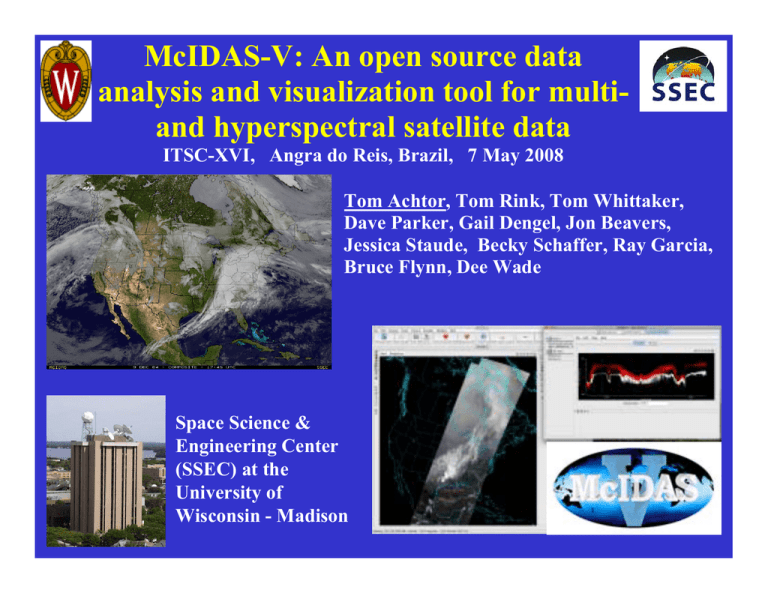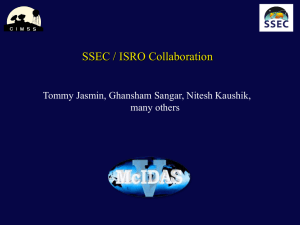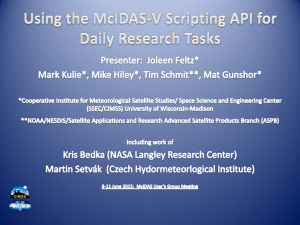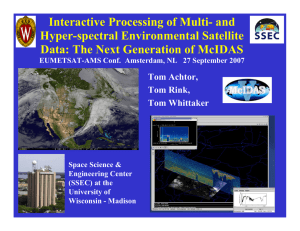McIDAS-V: An open source data analysis and visualization tool for multi-
advertisement

McIDAS-V: An open source data analysis and visualization tool for multiand hyperspectral satellite data ITSC-XVI, Angra do Reis, Brazil, 7 May 2008 Tom Achtor, Tom Rink, Tom Whittaker, Dave Parker, Gail Dengel, Jon Beavers, Jessica Staude, Becky Schaffer, Ray Garcia, Bruce Flynn, Dee Wade Space Science & Engineering Center (SSEC) at the University of Wisconsin - Madison What is McIDAS ? (Man computer Interactive Data Access System) • Collection of user programs and libraries for visualizing and analyzing geophysical data (focus on environmental satellites) – UNIX, PC & Mac capable • A synergistic tool that integrates numerous data types into one system • First developed in the early 1970s • Still in use world-wide at research, operational, educational, and commercial sites McIDAS-X Users (MUG has about 50 members) • NOAA – NESDIS, AWC, SPC, TPC, etc. • NASA – STS, LaRC, MSFC, JPL • Unidata – 130 universities, colleges and international educational collaborators • International – EUMETSAT, Spain, Greece, Mexico, Australia • Industry –Honeywell, Weathernews, Universal Weather, Meteorlogix, Weather Central, etc. Why the Change? • McIDAS software (written in Fortran 77 & C) has a 30+ year heritage resulting in limited potential • METOP, NPOESS and GOES-R operational satellite data cannot be optimally utilized – great increase in data rates – new tools for working with these large data sets • Platform / OS dependence • New data analysis and visualization concepts are now available (e.g. 4-D) McIDAS-V Requirements • Create a powerful and versatile software system for environmental data processing, analysis and visualization • Continue to fully support McIDAS Users’ Group (MUG) and McIDAS-X functionality as users transition to McIDAS-V • Support existing and evolving needs of scientific research and algorithm/applications development for new programs • Support operational users by providing frameworks in McIDAS-V, enabling a natural transition path for research results into operations • Use system to educate students in remote sensing and physical sciences; involve students in its development, evolution and use What is McIDAS-V McIDAS-X Æ VisAD + IDV + HYDRA = McIDAS-V VisAD Developer: Bill Hibbard, UW SSEC • Open-source, Java library for building interactive and collaborative visualization and analysis tools • Features include: – Powerful mathematical data model that embraces virtually any numerical data set – General display model that supports 2- and 3-D displays, multiple data views, direct manipulation – Adapters for multiple data formats (netCDF, HDF-5, FITS, HDF-EOS, McIDAS, Vis5D, etc.) and access to remote data servers through HTTP, FTP, DODS/OpenDAP, and OpenADDE protocols – Metadata can be integrated into each data object IDV-Integrated Data Viewer Developers: Unidata (Don Murray/Jeff McWhirter) • Unidata developed, VisADbased, scientific analysis and visualization library and toolkit • Open Source, Java™ framework and reference application • Provides 2- and 3-D displays of geo-scientific data (plus, of course, animations) • Stand-alone or networked application http://www.unidata.ucar.edu/idv Why VisAD and IDV? • VisAD brings the Data Model and advanced display capabilities • IDV is a “reference application” that provides a framework for fetching, selecting and displaying data • Both in Java and Open Source • Use Jython (Python running in Java) as scripting language • Many other supporting libraries available The “X to V” Bridge • Interacts with a McIDAS-X remote session • Users provides command line input in a McIDAS-V Data Chooser that sends commands to a server running McIDAS-X • Runs all McIDAS-X commands, including status, text, imagery and graphics – McIDAS-X output displayed in McIDAS-V • Allows bi-directional interactive communication between McIDAS-V and McIDAS-X The “X to V” Bridge HYDRA Interrogation of multi- and hyper-spectral data Developer: Tom Rink SSEC – Display individual pixel location and spectral band measurements – Combine spectral channels in linear functions and display resulting image products – Construct false color images from multiple channel combinations – Create scatter plots of spectral channel combinations – Locate image pixels in scatter plots and vice versa – Display transects of measurements – Compare Level 2 products (e.g. soundings of temperature and moisture as well as spectra from selected pixels) – Integrated data and product analysis/evaluation between Geostationary and Polar observing platforms Mt Etna viewed by AIRS 28 Oct 2002 SO2 signal 1284-1345 cm-1 Inferring ash cloud height from AIRS clear sky and in ash soundings Ash cloud and clear sky spectra Offline-Online in LW CO2 Offline-Online in H2O Hydra Integration into McIDAS-V IASI granule Hydra Integration into McIDAS-V pointers select location of spectra Hydra Integration into McIDAS-V slider bar selects spectral band display McIDAS-V web page software, manuals McIDAS-V is a collection of software tools, and networked services and data designed to take advantage of a scalable distributed computing environment to meet user needs GIS Cluster OpenDAP/ computing ADDE McIDAS-V GeoCAT Database/ McIDAS-X SAN Matlab/IDL McIDAS-V Future Work • Complete HYDRA integration (summer ‘08) • Further enhancement of the ‘X to V Bridge’ – Alpha 0.6 release at 10/2007 MUG meeting • Provide full capabilities for Direct Broadcast data acquisition, analysis and display • Support data analysis and visualization capabilities and applications for advanced satellite systems, including METOP, NPP/NPOESS and GOES R – Innovative data analysis and visualization tools – Broad array of formats and services – Data management and accessibility McIDAS-V software McIDAS-V is free, open source software available at http://www.ssec.wisc.edu/mcidas/software/v/ (google McIDAS-V) or contact tom.achtor@ssec.wisc.edu


